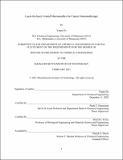Layer-by-layer coated microneedles for cancer immunotherapy
Author(s)
He, Yanpu.
Download1251767406-MIT.pdf (36.01Mb)
Other Contributors
Massachusetts Institute of Technology. Department of Chemical Engineering.
Advisor
Paula T. Hammond and Darrell J. Irvine.
Terms of use
Metadata
Show full item recordAbstract
Over the past few decades, research in therapeutic cancer vaccines has achieved remarkable advances in both pre-clinical and clinical studies. However, strategies to boost antigen presentation and T cell priming in order to increase the fraction of patients responding to immunotherapy remains an urgent need. For the delivery platform, we applied microneedle (MN) skin patches to transdermally deliver vaccines to activate the potent epidermal Langerhans cells and dermal dendritic cells. The drug was incorporated as a releasable multilayer coating on the microneedle surface constructed with alternating absorption of oppositely charged species including protein or nucleic acid drugs and biocompatible polymer carriers, forming a 'sticky' layer-by-layer (LbL) film through electrostatic attraction. Past LbL MN strategies have all retained this 'sticky' nature and therefore require a long application time (15-90 mins) for drug implantation. To resolve this problem, we devised a pH-induced charge-invertible polymer as a lift-off layer that significantly shortens the application time to 1 min. Our approach has inspired other work involving rapid film lift-off with charge-invertible species. On the drug side, we focused on the stimulator of interferon genes (STING) pathway. Current strategies mostly focus on developing synthetic vehicles to deliver the STING agonist, cyclic GMP-AMP (cGAMP) into the cells. However, this assumes the presence of fully functional STING protein to bind cGAMP. STING signaling has not only been shown to be frequently impaired in cancer cells due to epigenetic silencing of the protein; it is also under debate whether the overall population is responsive to delivery of just the agonist, since 19% of humans carry a mutated STING variant called HAQ STING that has been suggested to exhibit impaired function. To address these challenges, we engineered a recombinant STING protein without the transmembrane domain (STING[delta]TM) that could be used as a functional carrier for cGAMP delivery and elicit type I IFN expression in cell lines deficient of STING or with defective endogenous STING. In vivo, our cGAMP-STING[delta]TM signaling complex elicited enhanced antigen specific B and T cell responses as well as robust anti-tumoral immunity in a B16 melanoma and a MC38 colon cancer mouse model.
Description
Thesis: Ph. D., Massachusetts Institute of Technology, Department of Chemical Engineering, February, 2021 Vita. Cataloged from the official PDF of thesis. Includes bibliographical references.
Date issued
2021Department
Massachusetts Institute of Technology. Department of Chemical EngineeringPublisher
Massachusetts Institute of Technology
Keywords
Chemical Engineering.